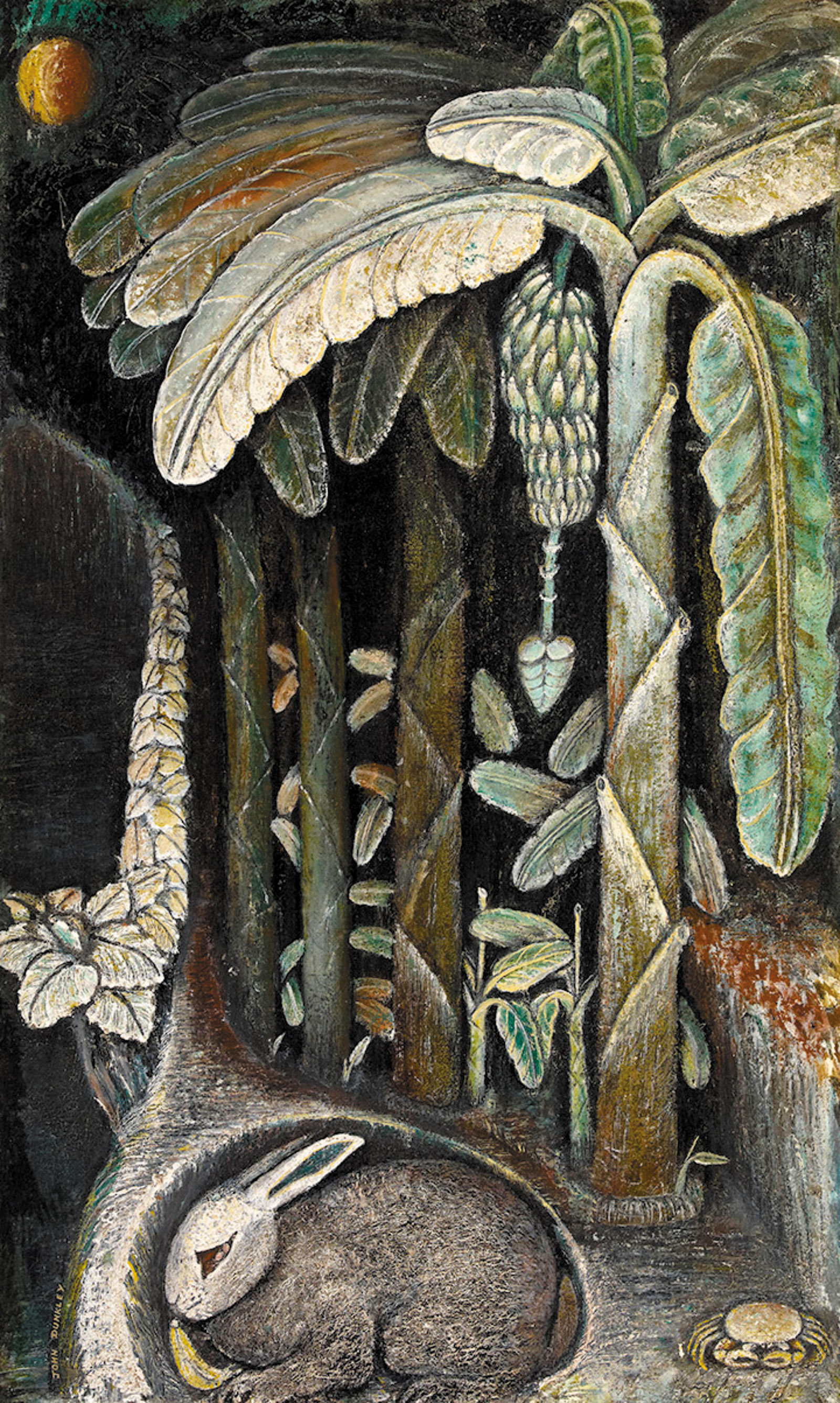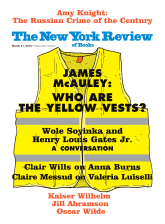In recent years art gallery and even museum shows have come to sport titles in addition to the name of the artist on view. Many of them are forgettable—they are flourishes, really—but the subtitle of the John Dunkley exhibition at the American Folk Art Museum, “Neither Day nor Night,” precisely captures one of the most distinctive aspects of his paintings. Dunkley, who died in 1947 at fifty-six, was a Jamaican artist who made mostly landscapes and whose scenes often have a particular light, which is inseparable from their ambiguous mood and spirit. Looking at his modestly sized canvases, we are often uncertain what time of day it is, or whether the orb we sometimes see poking out behind trees is the sun or the moon. Even on the rare occasions when his pictures present a pale or daytime sky skirting the top edge of the scene, there is a sense that darkness, like an atmospheric blanket, is there at the back and is spreading forward.
The exhibition, which began at the Pérez Art Museum Miami—the excellent catalog is in Spanish and English—brings the American audience its first-ever look at Dunkley, whose engaging small wood sculptures, all of the human figure or animals, are on view along with his paintings. Dunkley the painter was rarely a creator of showstopping, immediately memorable images. His pictures, on a quick first view, seem rather similar, and their predominantly earthen and brown-white, and green and green-white, tones, mixed in with an abundance of black, create an overall, almost metallic, somberness.
But a little extra time in the company of Dunkley’s canvases makes one see, to the great benefit of the work, how inherently abstract, even artificial, these landscapes are. They take us less to Jamaica (or to the island of popular imagination) than into the mind of someone who happened to be Jamaican. Dunkley’s pictures, which generally are not of particular places in his country, are in many instances like crosses between little theater sets and the creations of a landscape architect. The painter’s characters, so to speak, are meaty plants, assertive leaves, and cumbrous rosettes (or clusters of leaves), which he makes resemble heads of enormous cauliflowers. There are tidy stone walls, brand-new-looking log fences, and strange cut-down trees, which stick out here and there like baseball bats and can strike viewers, we read in the catalog, as “unabashedly phallic.”
Like his headstrong shrubs, Dunkley’s thrusting tree remnants have more presence than the occasional person in his pictures. In the beautiful Going to Market, we look less at a woman on a mule than at the marvelously painted canopy of succulents hanging over her. The most vivid being in Dunkley’s paintings may be a large, pensive rabbit that has taken a since-I-am-immobile-you-don’t-see-me pose at the base of Banana Plantation (circa 1945). Above our creature is as finely conceived an array of trees and leaves as the artist devised. This is a tremendously lovable painting.
Yet just as alive as Dunkley’s spotlit foregrounds are his deep, dimly illuminated backgrounds. They are marked by roads or canals—or allées, river beds, shoreline bluffs, or walkways—that swerve, or zoom off in straight lines, into complete darkness. Next to the stilled and emphatic vegetable life at center stage, these many routes to or from somewhere provide a welcome cursive elegance and sense of movement. We are not sure if they represent invitations to depart from our garden world or stand for uncertainties that our garden world keeps us from facing.
Dunkley’s pictures for the most part are undated, but a viewer senses that those with more complicated roadways or ravines in the background were made later. They imply an artist going further into his idea of space. In the undated and superb Spider’s Web, the many sweeping paths and lines of fencing in the background create such a flowing yet entangled web of markers and forms as to suggest the fantasy prisons envisaged by Piranesi. If all these routes and lines were not enough, Dunkley has set in the foreground of his painting an elaborate double spider’s web.
Dunkley was at work as an artist from the mid-1930s, when he was in his mid-forties, until his untimely death, some ten years later, from cancer. Prior to that, he lived and sought work largely in Central America, though the only document we have about his time away from Jamaica says merely that he was employed for a year at a banana company in Panama. Back home, he set himself up as a barber in Kingston, and apparently this is how he supported himself and his family for the rest of his life. As a painter, he was essentially self-taught, and he might be called a naif or a folk artist. Like other such creators, he often seems to be winging it with his forms or delineations of space. Yet while labeling an artist a naif or an outsider has long been enough to explain fully who that artist was, it increasingly speaks, I believe, for only an aspect of that artist’s makeup. One of the healthier features of our current thinking about art is that we are coming to see all artists, no matter what their training or the circumstances of their lives, as needing primarily to be judged by the ways in which their work is or is not alive.
Advertisement
Even without our new receptivity to art from all quarters, much about Dunkley, such as the indeterminate way he renders light and space, resists categorization. He left no written or oral records about anything, but thanks to the research of David Boxer, a Jamaican scholar and artist whose study of Dunkley forms the core of the catalog, we know a fair amount about how he operated. Jamaica, in his lifetime, was a “true apartheid’’ society, which severely limited what headway Dunkley, who was black, could make. Though he was not an actively political person, he kept abreast of the racial issues of the day. He was proud of the achievements of blacks in public life, and he firmly admired Marcus Garvey and the black nationalism he espoused.
Boxer, who is a sensitive and convincing describer of artworks, makes us particularly aware of the lively and supportive milieu that his subject was part of. He has combed the pages of the Daily Gleaner, a Kingston newspaper that noted Dunkley’s work, and of Life, with whose images Dunkley was familiar; and he can refer to the relevant art books, lectures, and art magazines that were everyday parts of the life of the Institute of Jamaica in these years. It seems to have provided almost a second home to the artist. We learn about Dunkley’s coming into contact with Henri Rousseau’s primitivism, with Blake, with the Surrealist trends of the moment, and with the budding interest in African sculpture and the idea of a black consciousness in art.
When Dunkley was starting out as an artist, his work was met with fervor by Hender Delves Molesworth, an English art historian who had recently been made head of the institute. It was Molesworth who, in a surprising twist, urged Jamaican artists, even as they were absorbing the European and African art coming their way, to become aware especially of the power of ancient Chinese art. Perhaps it was this work that contributed to Dunkley’s feeling for immeasurable distances.
His sculpture might stand for yet another aspect of this artist’s elusiveness, because his wood carvings would seem to have little relation to his painting. Although a few of his sculptures are perfunctory in technique, Dunkley, working with such subjects as a glamorous woman in heels perched on a stool, or street urchins in a cart, or a boxer who is no longer young, was a highly proficient, even stylish handler of his materials. If, like the present writer, you have an affection for intimately sized representational sculpture in general, you will be especially happy that these pieces have come to light. But Dunkley’s sculpture lacks what his paintings have: a large, underlying idea. What was that idea? It might be called an unrelenting, if subtle, need to show uncertainty.




